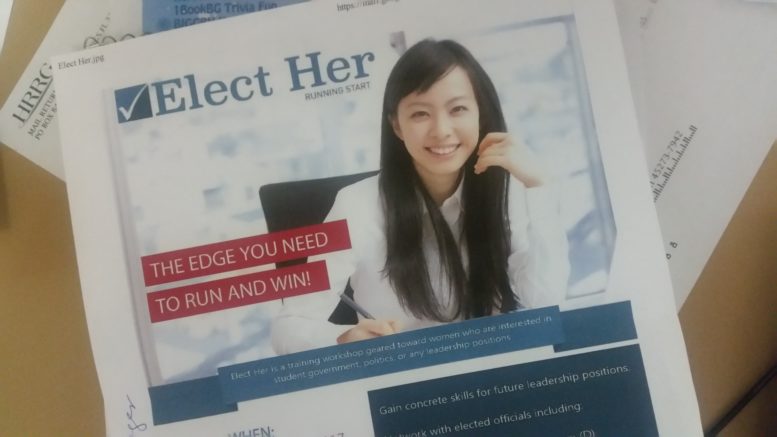By JAN LARSON McLAUGHLIN
BG Independent News
Women are still playing catch up attaining elected positions in the U.S.
Statistics show that when women run for elected offices, they are elected at the same rate as men, according to Mary Krueger, director of BGSU Women’s Center. The disparity exists because fewer women throw their hats into the rings as candidates.
“They don’t run nearly as often,” Krueger said. “Let’s get past this.”
To help young college age women interested in attaining public office, the BGSU Women’s Center is offering a program called “Elect Her,” on Saturday. The workshop is designed for women eyeing spots in student government, politics or any leadership positions.
According to the Center for American Women and Politics, the following offices are filled by far fewer women than men. The statistics show:
- U.S. Senate: 21 percent women; 16 Democrats and 5 Republicans.
- U.S. House: 19 percent women; 62 Democrats and 21 Republicans.
- State senates: 22 percent women; 253 Democrats, 175 Republicans, 13 non-partisan, 1 Independent.
- State houses: 26 percent women; 854 Democrats, 528 Republicans, 4 Progressive, 3 Independent, 1 Working Families Party.
- State governors and other state elected officials: 24 percent, 32 Democrats, 41 Republicans, 1 non-partisan.
- Mayors of 100 largest cities: 19 percent women.
- Mayors of cities with over 30,000 population: 19 percent women.
The disparity certainly is not due to competence, Krueger said. However, it could be partially due to men getting a couple centuries’ advantage. It has not even been a full century since women gained the right to vote in 1920 with the 19th Amendment.
“Over generations in this country, women have been discouraged from running for office,” Krueger said. “There’s a legacy of being forbidden. The men have had a couple hundred years’ head start.”
This is the second time the “Elect Her” workshop has been hosted by the Women’s Center. Krueger said she had no idea of the heightened relevancy it would have – with so many women now being involved in or inspired by the national women’s marches.
“When we planned this and picked this date, we didn’t know what would be going on in the nation and the world,” she said.
“It certainly is especially timely,” Krueger said. “I’m hoping some of the energy of the women’s marches can be captured.”
Speaking at the workshop are some candidates with experience running and getting elected. They are State Senator Edna Brown, State Senator Teresa Fedor, Findlay Mayor Lydia Mihalik and Bowling Green Councilman Daniel Gordon, who has experience running for office while still in college.
“The women will be getting a chance to see women who have made it,” Krueger said, noting the diversity in party, age and ethnicity of the speakers.
Studies show that women who get involved in government or leadership positions during college are more likely to continue that later in life, Krueger said.
“They are significantly more likely to go on to run for office later,” she said.
The goal doesn’t have to be a national office. Often it helps to start small – on a school board, as a county commissioner, or state office.
“We can help the young women see the value of when you start here,” it can lead to more, Krueger said. “The important thing is to contribute.”

